Simmered Sardines with Pickled Plum is the dish that lets you eat the entire body of the sardine including the bones. The umeboshi (pickled plum), sake, and ginger in the simmering sauce eliminates the strong fishy smell of the sardines. They also make the bones so tender that you can eat them.
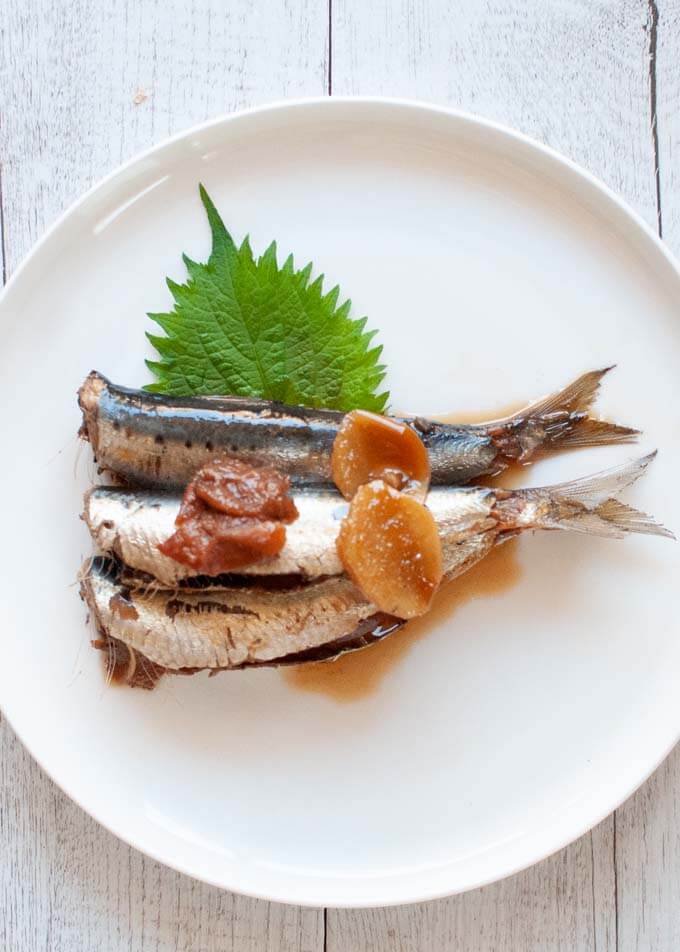
Looking at all the images of sardine dishes on the internet, it seems that Simmered Sardines is a unique way of cooking sardines. Most sardine recipes are either grilled, fried, or roasted. And of course, some recipes use canned sardines.
Today’s recipe, Simmered Sardines with Pickled Plum, is a typical Japanese home-cooking recipe. The dish goes so well with rice, but I think that it can also be a great appetiser with Japanese sake or other drinks.
Sardines used to be extremely cheap in Sydney. About 40 years ago, sardines were $1-2 per kilo. Aussies perhaps used sardines only as fishing bait. Now, the price has gone up to over $10, although they are still cheaper than most fish. And they are good for you.
About Ume-ni
When you simmer fish, meat or vegetables in a broth/sauce with umeboshi (梅干し, pickled plum), the dish is called ‘ume-ni’ (梅煮). It translates to ‘simmered with plum’, but in this case the plum means pickled plum, i.e. umeboshi.
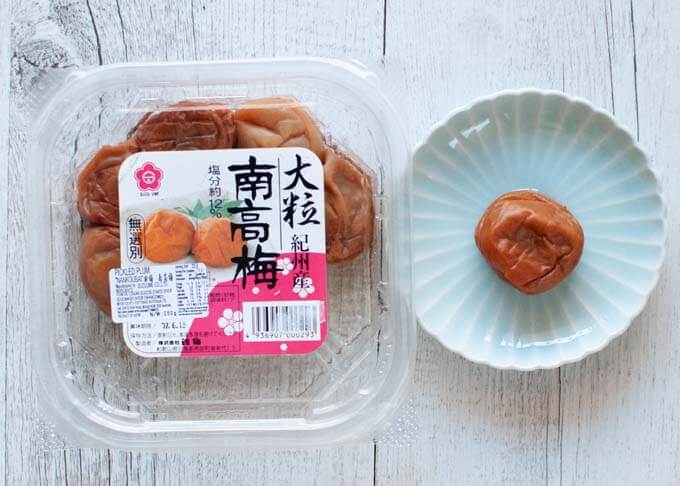
There are many different kinds of umeboshi, and I talked about them in my post Daikon Salad with Pickled Plum Dressing. In the case of ume-ni, you need to use large, brown, soft umeboshi, like the on in the above photo.
The sourness of umeboshi can vary and some soft umeboshi might even come with other seasonings such as bonito flakes. For the simmering, the simple standard umeboshi is the best.
What’s in My Simmered Sardines with Pickled Plum
The main ingredients are sardines, umeboshi, and ginger. Rice vinegar and water are required for pre-cooking the sardines.
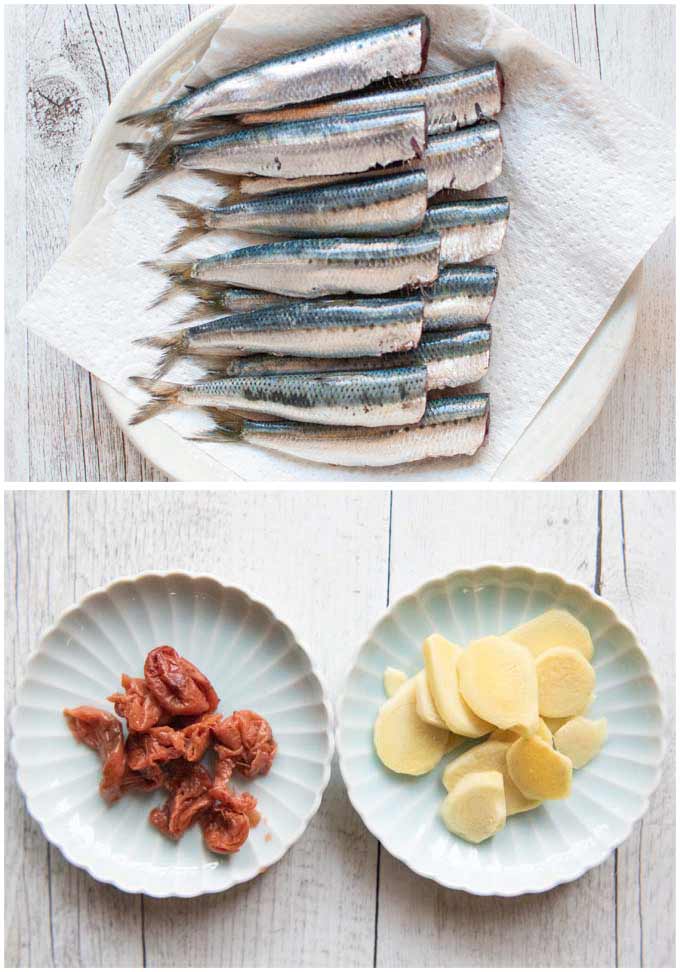
- Sardines
- Umeboshi – deseeded and torn into small pieces
- Sliced ginger
- Rice wine vinegar
- Water
It is easy to remove a seed from a soft umeboshi. Simply break the skin and remove the seed. Try to take flesh around the seeds as much as possible. Before discarding the seeds, I always suck the seeds. They are pretty tasty. I sometimes put 3-4 seeds in a small cup and add hot water to make a mildly flavoured umeboshi drink.
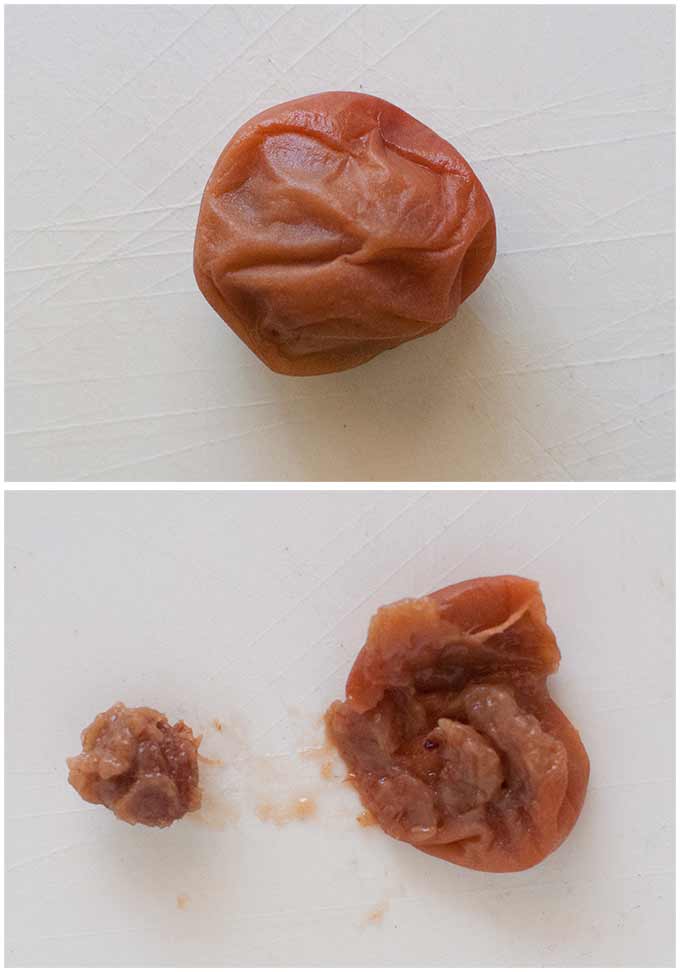
For this dish, it is critical to obtain very fresh sardines. If the sardines are not fresh, they not only smell fishy but also break more easily, and the skin peels off while cooking. Please see the subsequent section which gives you a check list to determine if sardines are fresh or not.
Simmering Sauce
- Water
- Soy sauce
- Cooking sake
- Mirin
- Sugar
Unlike the typical simmering sauce/broth used in Japanese cooking, you don’t use dashi stock for Simmered Sardines with Pickled Plum. It is a common rule not to use dashi stock when you simmer fish with bones intact. It is because you get a good stock from the fish.
How to make Simmered Sardines with Pickled Plum
Preparation of sardines requires care so that the fish retains its original shape without scratches and tears.
Prepare sardines:
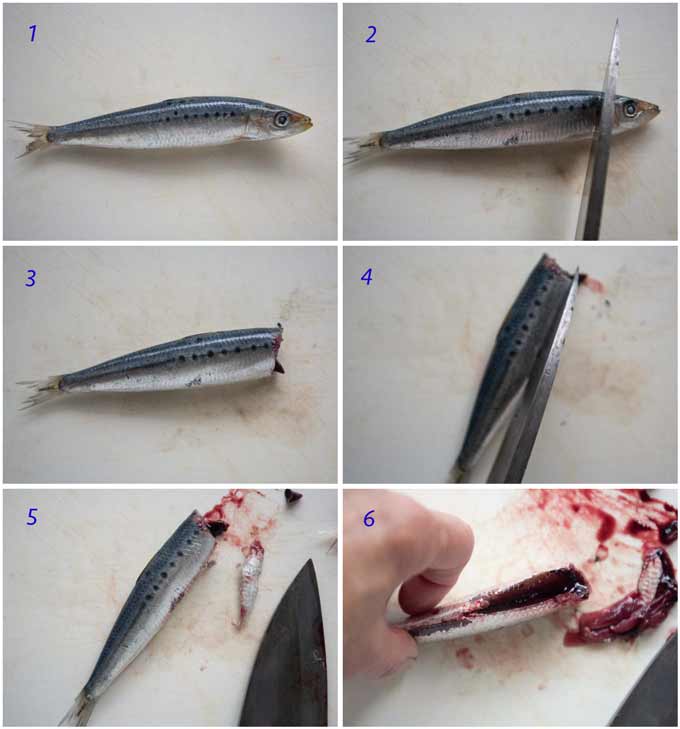
- If the sardines came with scales, gently scrape the scales off the body, using the back of a small knife.
- Remove the head of the sardines by cutting it off from directly behind the gills (2 & 3 in above photo).
- Place a knife close to the edge of the belly and trim the belly tissue off. The trimming should end at the anus (4 & 5 in above photo).
- Remove the guts by scraping them out of the cavity using the tip of the knife. Photo 6 above shows empty stomach of the sardine after scraping the guts out.
- Rinse the sardines gently, cleaning the cavity where the guts were.
There are two major stages to cooking sardines so that even the back bones become tender.
Pre-cooking:
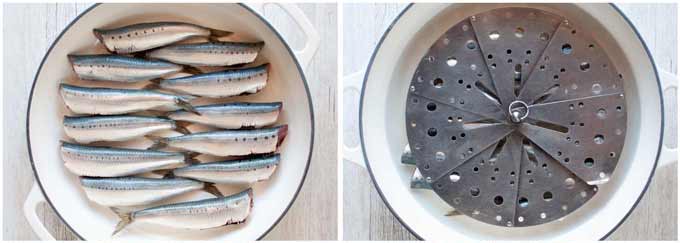
- Place the sardines in a shallow saucepan, without overlapping. Add water and vinegar and boil for 15 minutes.
- Drain the vinegar water. It is easier if you use the drop lid to hold the sardines.
Simmering:

- Add the simmering sauce to the saucepan with the sardines in it.
- Scatter umeboshi pieces and sliced ginger over the sardines, then bring it to a boil.
- Reduce the heat to simmer and cook for about 15 minutes.
Cooking the whole sardines in the vinegar water makes the bones tender. In addition to that, adding umeboshi to the simmering sauce further tenderises the bones.
How to tell if sardines are fresh
The sardine is one of the shiny blue skin fish that can go bad quickly. When it is not fresh, the skin breaks easily and the thin meat around the guts breaks. At fish shops or the seafood section of supermarkets, you sometimes see the sardines with broken bellies.
Even if the sardines in this state are sold cheap, don’t buy them for today’s dish. Fresh sardines make a huge difference to the taste and the presentation of Simmered Sardines.
Here are the few points to remember when checking for freshness in sardines.
Eyes:
- The eyes are clear, shiny and plump (not sunken).
- The pupils are pitch black.
- Reddish eyes indicate the fish is not very fresh.
Gills:
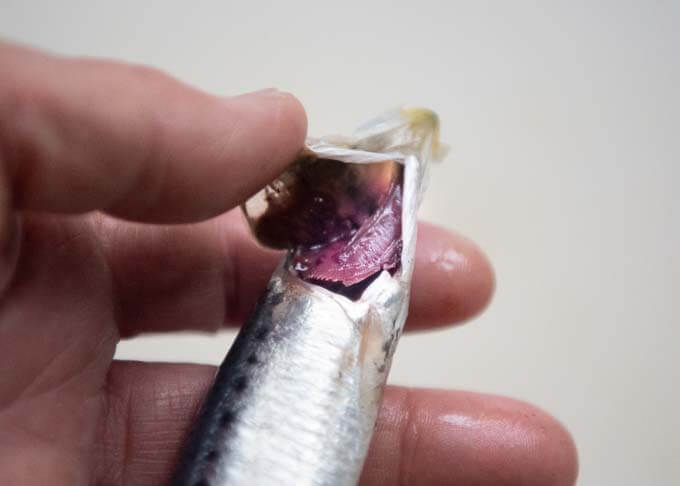
- Reddish gills indicate freshness.
- If the gills are brownish, blackish, or yellowish, the fish is not fresh.
Body:
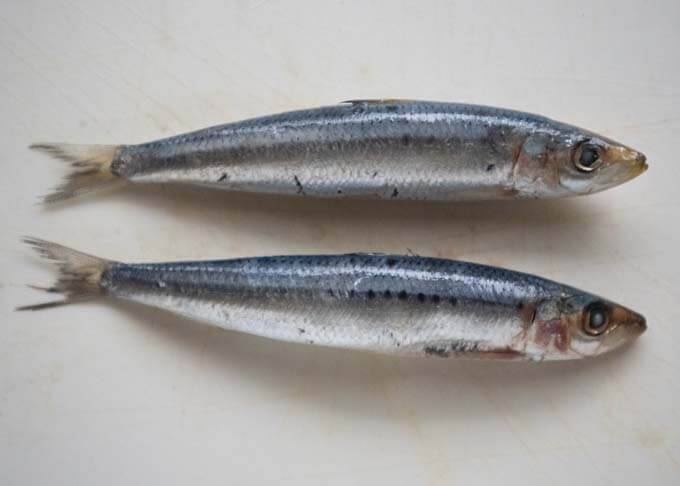
Note the bottom sardines started breaking the belly. Tiny damage like this sardine is OK.
- There is no breakage around the guts.
- The body is plump.
- The skin is clean and shiny with no damages.
- The patterns on side, such as dots (if they have), are clear.
- Sardines with scales intact are considered to be fresh, but the surface should not be dry.
If you can clear all the points above, your sardines are very fresh. Slight damages on skin and the belly area (like the bottom sardine in the photo above) are OK.
There is one more thing you can check to determine if the sardines are the best. This is nothing to do with the freshness but to see if the fish is oily (= tasty) or not.
Find the sardines with small heads relative to the body. This means that the body is plumper than other sardines, containing more fat. Have a top-down view of the body of the sardine to check the width of the body. The wide body indicates more fat.
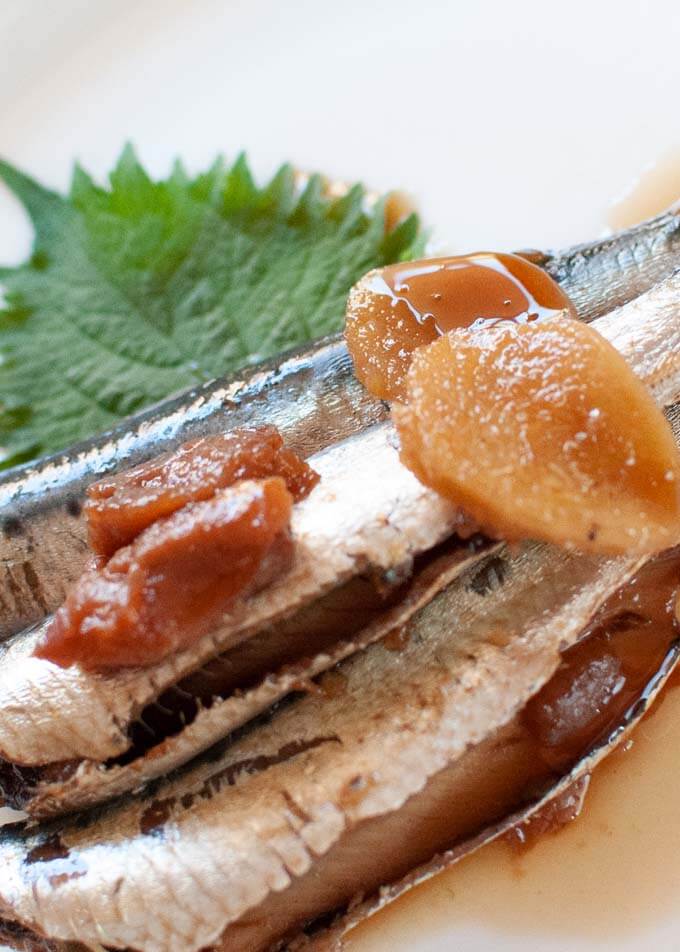
The slightly sweet, salty, and sour flavoura of the sardines go very well with rice. They keep 2-3 days in the fridge. They taste good even if they are served cold.
Yumiko![]()
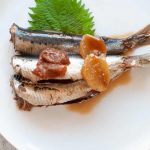
Simmered Sardines with Pickled Plum is the dish that let you eat the entire body of the sardine including the bones.
Umeboshi (pickled plum) and sake in the simmering sauce eliminates the strong fishy smell of the sardines. It also makes the bones so tender that you can eat even the backbones.
Don't forget to see the section 'MEAL IDEAS' below the recipe card! It gives you a list of dishes that I have already posted and this recipe that can make up a complete meal. I hope it is of help to you.
- 12 sardines (about 750g / 1.7lb, note 1)
- 20g / 0.7oz ginger thinly sliced
- 20g / 0.7oz umeboshi , seed removed and torn into few smaller pieces (note 2)
- 400ml / 13.5oz water
- 90ml / 3.0oz rice vinegar
- 300ml / 10.1oz water
- 4 tbsp soy sauce
- 4 tbsp cooking sake
- 2 tbsp mirin
- 1 ½ tbsp sugar
- Perilla leaves
-
Remove the head of the sardines by cutting it off from directly behind the gills.
-
Place a sharp knife close to the edge of the belly and trim the belly tissue off (note 3). The trimming should end at the anus.
-
Remove the guts by scraping them out of the cavity using the tip of the knife or use fingers (note 3).
-
Rinse each sardine gently, cleaning the cavity where the guts were.
-
Place the sardines in a shallow saucepan, without overlapping (note 4). Add the Pre-cooking ingredients to the pan and bring it to a boil.
-
Reduce the heat to simmer and put a drop lid (otoshibuta) on. Cook for 15 minutes.
-
Drain the vinegar water by holding the fish with the drop lid to keep the fish in the pan.
-
Adjust the position of the sardines in the pan so that they are evenly spread without overlapping.
-
Add the Simmering Sauce to the pan, scatter the ginger and the pickled plum pieces over the fish. Bring it to a boil.
-
Reduce the heat to simmer and put a drop lid (otoshibuta) on. Cook for about 15 minutes until the liquid reduces and only a small amount of sauce remains.
-
Place a perilla leaf on each serving plate, if using. Transfer 3-4 sardines onto each plate.
-
Place the cooked ginger and umeboshi pieces on top of the pile of sardines.
1. After cleaning the sardines, they weighed about 500g / 1.1lb.
2. Umeboshi comes in different sizes, textures, colours, and flavours. Use large brown soft umeboshi (see the photo in the post) that do not have additional flavouring such as perilla and bonito flakes.
3. The belly part of the flesh is extremely fragile and can be torn easily. So, make a clean straight cut and remove the guts gently.
4. It is best to use a saucepan that sardines can be snuggly placed in without overlapping.
If the pan is too large, the sauce becomes too shallow and does not easily penetrate into the flesh of the fish. If the pan is too small, forcing you to pile up sardines, the sauce does not reach to the top of the pile.
5. Simmered Sardines with Pickled Plum keep 2-3 days in the fridge. They taste good even if they are served cold.
6. Nutrition per serving assuming 4 servings.
serving: 252g calories: 268kcal fat: 8g (12%) saturated fat: 2.3g (12%) trans fat: 0.0g polyunsaturated fat: 2.3g monounsaturated fat: 2.7g cholesterol: 91mg (30%) sodium: 972mg (41%) potassium: 798mg (23%) carbohydrates: 11g (4%) dietary fibre: 0.3g (1%) sugar: 8.5g protein: 31g vitamin a: 3.7% vitamin c: 4.6% calcium: 2.1% iron: 7.3%
Meal Ideas
A typical Japanese meal consists of a main dish, a couple of side dishes, a soup and rice. I try to come up with a combination of dishes with a variety of flavours, colours, textures and make-ahead dishes.
Today’s main, Simmered Sardines, is a small serving. So, I picked Hiyayakko and Tonjiru to supplement protein. If you want to avoid meat, you can replace Tonjiru with Kenchinjiru.
Tonjiru and Spinach Ohitashi Salad give you a variety of vegetables. They also add colours to the meal.
- Main: Simmered Sardines with Pickled Plum – today’s recipe, make ahead
- Side dish 1: Chilled Tofu (Hiyayakko) 4 ways – with a topping of your choice
- Side dish 2: Spinach Ohitashi Salad – or other vegetable dish
- Soup: Tonjiru (Pork and Vegetable Miso Soup) – or Japanese Vegetable Soup (Kenchinjiru).
- Rice: Cooked Rice
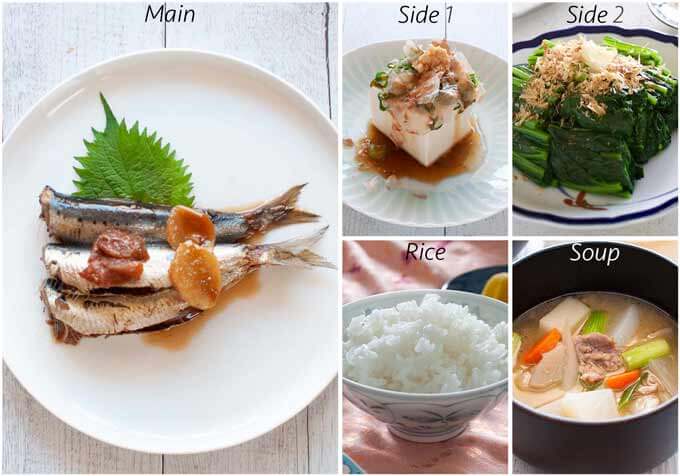

Is it possible to use thawed sardines? They sell them frozen at my market.
Hi Char, as long as the sardines are not too soft and fragile after thawing, I can’t see why you can’t use them.
Hello Yumiko,
This looks great. Could I use mackerel to do this or small herring?
Thank you
Hi Dee, small herring is better. My sardines were about 10cm / 4″ long. I hope you like it!